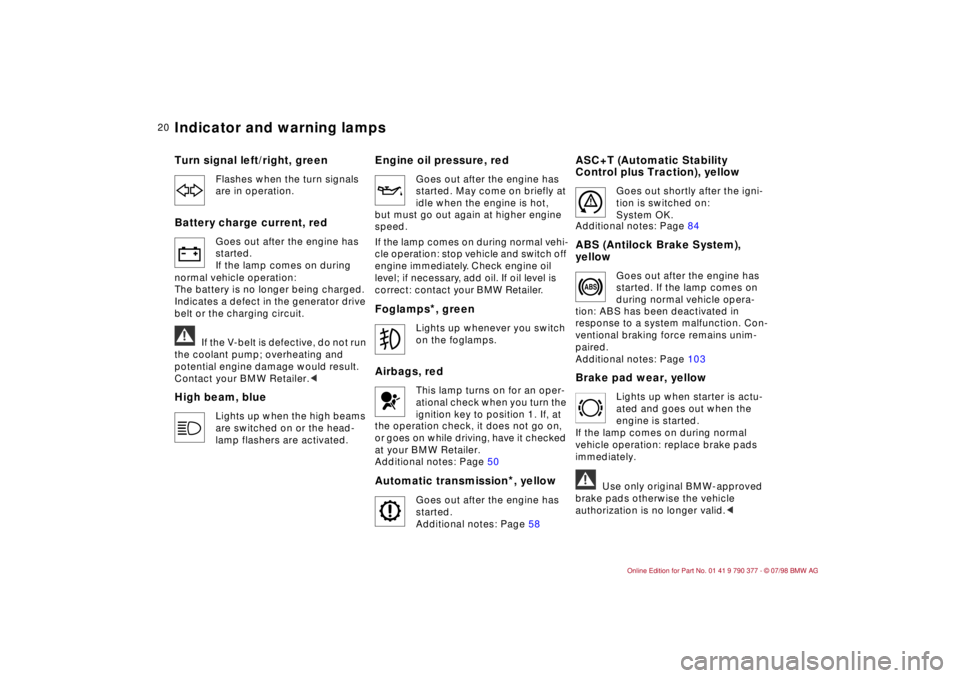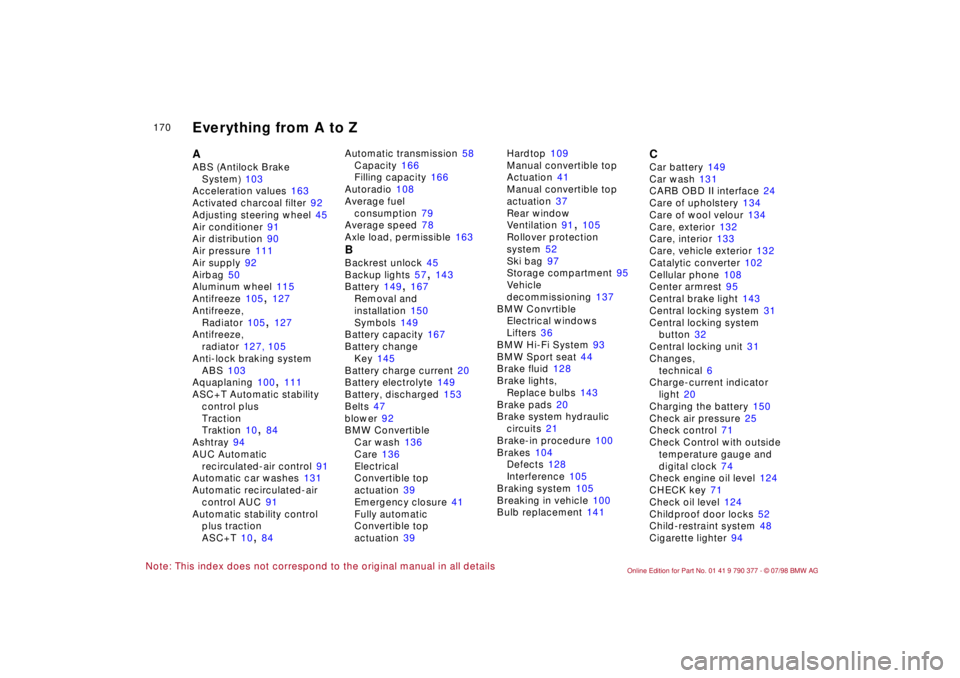1998 BMW CONVERTIBLE brake pads
[x] Cancel search: brake padsPage 21 of 179

20
Turn signal left/right, green
k
Flashes when the turn signals
are in operation.
Battery charge current, red
v
Goes out after the engine has
started.
If the lamp comes on during
normal vehicle operation:
The battery is no longer being charged.
Indicates a defect in the generator drive
belt or the charging circuit.
a
If the V-belt is defective, do not run
the coolant pump; overheating and
potential engine damage would result.
Contact your BMW Retailer.
c
High beam, blue
l
Lights up when the high beams
are switched on or the head-
lamp flashers are activated.
Engine oil pressure, redw
Goes out after the engine has
started. May come on briefly at
idle when the engine is hot,
but must go out again at higher engine
speed.
If the lamp comes on during normal vehi-
cle operation: stop vehicle and switch off
engine immediately. Check engine oil
level; if necessary, add oil. If oil level is
correct: contact your BMW Retailer.
Foglamps
*, green
t
Lights up whenever you switch
on the foglamps.
Airbags, redp
This lamp turns on for an oper-
ational check when you turn the
ignition key to position 1. If, at
the operation check, it does not go on,
or goes on while driving, have it checked
at your BMW Retailer.
Additional notes: Page 50
Automatic transmission
*, yellow
O
Goes out after the engine has
started.
Additional notes: Page 58
ASC+T (Automatic Stability
Control plus Traction), yellows
Goes out shortly after the igni-
tion is switched on:
System OK.
Additional notes: Page 84
ABS (Antilock Brake System),
yellowo
Goes out after the engine has
started. If the lamp comes on
during normal vehicle opera-
tion: ABS has been deactivated in
response to a system malfunction. Con-
ventional braking force remains unim-
paired.
Additional notes: Page 103
Brake pad wear, yellow#
Lights up when starter is actu-
ated and goes out when the
engine is started.
If the lamp comes on during normal
vehicle operation: replace brake pads
immediately.
a
Use only original BMW-approved
brake pads otherwise the vehicle
authorization is no longer valid.c
Indicator and warning lamps
Page 101 of 179

10 0
To ensure that your vehicle provides
maximum economy throughout a long
service life, we request that you
observe the following.
Engine and differentialUp to 1,250 miles (2,000 km):
Drive at different engine speeds and
vehicle speeds, but be careful not to
exceed the following engine speed:
4,500 rpm
Refrain from using full throttle and avoid
pressing the accelerator beyond the
kickdown point.
After 1,250 miles (2,000 km) you can
gradually increase the number of revo-
lutions or the speed.
You should also observe these break-in
procedures if the engine or differential
is replaced later in the course of the
vehicle service life.
TiresDue to technical factors associated with
their manufacture, tires do not achieve
their full traction potential until an initial
break-in period has elapsed. This
means that you should drive with addi-
tional caution for the first 200 miles
(300 km).Brake systemBrake pads and disks attain their opti-
mal wear patterns only after approx.
300 miles (500 km).
EngineDo not allow the engine to warm to its
normal operating temperature by leav-
ing it idling with the vehicle parked.
However, when starting in extremely
cold weather it is a good idea to allow
the engine to run at fast idle for about
30 seconds before getting underway;
this precaution ensures adequate lubri-
cation.
Avoid high engine speeds while the
engine is still cold; this helps avoid pre-
mature wear and reduced service life.
When driving under high engine loads
(acceleration, steep hills), try to keep
the engine running above 1,500 rpm.
We recommend downshifting into a
more suitable range, especially when
driving up extended inclines.
It is a good idea to follow extended
periods of low-speed operation (dense
urban traffic, stop-and-go driving) by
maintaining an engine speed consis-
tently above 3,000 rpm for several
miles. This procedure helps prevent
deposits from accumulating in the
engine.
Break-in procedures Driving notes
Page 105 of 179

10 4
Disc brakes furnish optimum decelera-
tion and braking control as well as
greater fade resistance under heavy
use.
Limited vehicle use, extended periods
with the car parked or in storage and
light loading will increase the tendency
for corrosion to form on the rotors, and
dirt to accumulate on the pads. This
happens because the minimum pres-
sure between the pad and the disc
required for the self-cleaning function
of the disc brakes is not achieved.
If the brake rotors are corroded, they
will tend to respond to braking with a
pulsating effect which even extended
application will fail to cure.
a
Use only original BMW-approved
brake pads, as otherwise vehicle autho-
rization is no longer valid.c
Driving notes While driving in wet conditions and in
heavy rain, it is a good idea to apply
light pressure to the brake pedal every
few miles - Watch traffic conditions to
ensure that this maneuver does not
endanger other road users. The heat
generated in this braking process helps
dry the brake pads and rotors.
Maximum braking force is obtained
while the wheels continue to rotate,
peaking when the wheels remain on the
verge of locking without actually doing
so. ABS maintains this state automati-
cally. If the ABS fails, you should revert
to the staggered braking technique
described above (refer to page 106).
Extended or steep mountain descents
do not necessarily have to lead to
reduced braking efficiency; downshift
to a gear in which only minimal periodic
brake applications are required (you
can move the selector lever to the
appropriate lower range if your car is
equipped with an automatic transmis-
sion).
You can further increase the engine's
braking effect by selecting a lower gear,
downshifting as far as first gear or plac-
ing the selector lever in position 1 (2).Should engine braking prove inade-
quate, you should still avoid extended,
continuous braking. Instead of main-
taining low to moderate pressure over
an extended period of time, you should
decelerate the vehicle by applying more
substantial force at the pedal (watch for
following traffic!) and then pausing
before repeating the application. This
staggered braking technique allows the
brakes to cool in the intervals between
active braking phases, preventing over-
heating and ensuring that full braking
capacity remains available at all times.
a
Do not allow the vehicle to coast by
pressing down the clutch pedal or shift-
ing into neutral while underway. Never
drive with the engine switched
off (!). The engine provides no braking
effect when the clutch is disengaged or
the transmission is in neutral, and there
is no power-assist for brakes and steer-
ing when the engine is not running.
Never allow floor mats, carpets or other
objects to protrude into the area around
the accelerator, clutch and brake pedals
and obstruct their movement.c
Disc brakes
Page 171 of 179

170
Note: This index does not correspond to the original manual in all details
AABS (Antilock Brake
System)
103
Acceleration values
163
Activated charcoal filter
92
Adjusting steering wheel 45
Air conditioner
91
Air distribution 90
Air pressure
111
Air supply
92
Airbag
50
Aluminum wheel
115
Antifreeze
105
, 127
Antifreeze,
Radiator
105
, 127
Antifreeze,
radiator
127, 105
Anti-lock braking system
ABS
103
Aquaplaning
100
, 111
ASC+T Automatic stability
control plus
Traction
Traktion
10
, 84
Ashtray
94
AUC Automatic
recirculated-air control
91
Automatic car washes
131
Automatic recirculated-air
control AUC
91
Automatic stability control
plus traction
ASC+T
10
, 84Automatic transmission
58
Capacity
166
Filling capacity
166
Autoradio
108
Average fuel
consumption
79
Average speed 78
Axle load, permissible
163
BBackrest unlock
45
Backup lights
57
, 143
Battery
149
, 167
Removal and
installation 150
Symbols
149
Battery capacity
167
Battery change
Key
145
Battery charge current
20
Battery electrolyte
149
Battery, discharged 153
Belts
47
blower 92
BMW Convertible
Car wash
136
Care
136
Electrical
Convertible top
actuation
39
Emergency closure
41
Fully automatic
Convertible top
actuation
39Hardtop
109
Manual convertible top
Actuation 41
Manual convertible top
actuation 37
Rear window
Ventilation 91
, 105
Rollover protection
system
52
Ski bag 97
Storage compartment
95
Vehicle
decommissioning
137
BMW Convrtible
Electrical windows
Lifters
36
BMW Hi-Fi System
93
BMW Sport seat
44
Brake fluid
128
Brake lights,
Replace bulbs
143
Brake pads
20
Brake system hydraulic
circuits
21
Brake-in procedure
100
Brakes
104
Defects 128
Interference
105
Braking system 105
Breaking in vehicle
100
Bulb replacement 141
CCar battery
149
Car wash
131
CARB OBD II interface
24
Care of upholstery
134
Care of wool velour 134
Care, exterior
132
Care, interior 133
Care, vehicle exterior
132
Catalytic converter
102
Cellular phone
108
Center armrest 95
Central brake light
143
Central locking system
31
Central locking system
button
32
Central locking unit
31
Changes,
technical
6
Charge-current indicator
light
20
Charging the battery
150
Check air pressure
25
Check control
71
Check Control with outside
temperature gauge and
digital clock 74
Check engine oil level
124
CHECK key
71
Check oil level 124
Childproof door locks
52
Child-restraint system 48
Cigarette lighter
94
Everything from A to Z